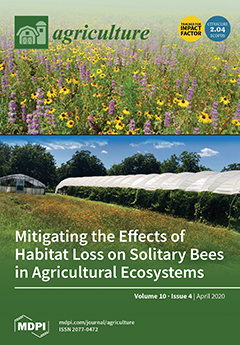The chemical composition of three
Silphium species in the aspect of the possibility of their use for various purposes has been evaluated. The plant material of three
Silphium species (
S. perfoliatum,
S. trifoliatum and
S. integrifolium) was acquired from cultivation
[...] Read more.
The chemical composition of three
Silphium species in the aspect of the possibility of their use for various purposes has been evaluated. The plant material of three
Silphium species (
S. perfoliatum,
S. trifoliatum and
S. integrifolium) was acquired from cultivation located in eastern Poland. The vegetative propagating material consisted of seeds and rhizomes. Content of protein (up to 22.9% in leaves of
S. perfoliatum), amino acids (aspartic acid—up to 12.0%, glutamic acid—up to 9.5%, and leucine—up to 9.4%), fat (up to 4.2% in inflorescences of
S. perfoliatum), cellulose (up to 42.9% in stems of
S. trifoliatum), water-soluble sugars (up to 26.7% in rhizomes of
S. perfoliatum) and mineral substances (ash up to 20.9% in stems of
S. integrifolium, with significant levels of elements such as K, Ca, Mg, Fe, Mn) in the tested
Silphium species can be an important criterion determining a positive evaluation of these plants as sources of alternative raw materials. The conducted research is meant to draw attention to the possibility of use of the biomass of three
Silphium species as a potential source of ecological and renewable raw material for food, pharmaceuticals, feed and possibly also for energy generation purposes.
Full article





